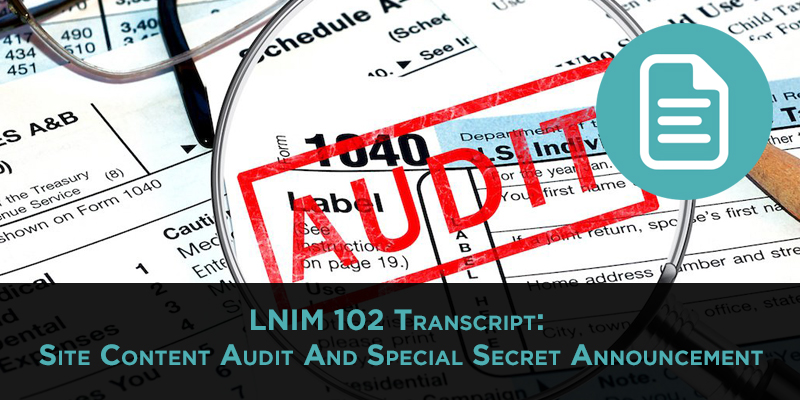(Transcript continued from the Episode 102 show notes and audio podcast)
For years and years I’ve been helping people one at a time launch something that looks like an affiliate website. Now, sometimes they’re straight affiliate websites like the kind that we talk about on this show. Sometimes they’re really blogs with an intention to monetize through affiliate offers. People are blogging about something that they really care about, but they know that they need to monetize that to really justify the time or they have a desire to monetize that to leave their day job or to make a side income, so they know they’re going to be doing affiliate marketing.
I’ve been doing a lot of those lately. The last two that I did were very interesting because I helped a very close friend of mine who lives down the street (his son plays on our baseball team, I’ve known him for years now) and he has started a website about his life as a pharmacist. You can go check it out over at HelpfulPharmacist.com.
This is a very good example of the kind of website that I love. Basically the idea of this website is this guy – my friend Brady – is a pharmacist and every day he helps people one at a time when they walk up to the counter and ask some question that he knows the answer to, or when someone like me texts him and says, “My kid has a runny nose, what over the counter drug can I give my kid?” or, “Is it okay to take this medicine with that medicine?” He helps people one at a time.
He realized that if he had a blog he could help more than one person at a time, maybe 10 people at a time or 100 people at a time. For example, he wrote a post demystifying all of these different nasal sprays that you’re just bombarded with all these commercials about. He wrote a simple post in layperson terminology that helps people decode what these different nasal sprays are all about.
Another example is when it was time for the program where you can turn in all of your old and expired drugs, where to turn them and how to turn them in, he wrote a post about that. Instead of helping one person at a time in his pharmacy, he can help more people. He wanted to do it in a way that was efficient so that he could gain traction quickly. Eventually I think his intention or his hope is to get some ROI on this endeavor by monetizing it.
I think that’s a really good example of the kind of affiliate marketing that we talk about on this show; creating information that helps people in some way and eventually leads them to make really good informed purchases that also help them. It’s kind of a win-win situation if you do affiliate marketing the same way.
The second one that I did is my wife’s blog. She’s a new blogger, I guess the genre is “mommy blogger,” although that makes my skin crawl a little bit. I think what she’s doing is considerably more sophisticated than something that I would call “mommy blogging,” as are most of the “mommy” blogs that I look at. They look to me to be a lot more than that. It’s just a one-dimensional term that I don’t really like.
My wife has her blog over at BallCapMom.com where she is trying to do kind of the same thing. She has all of these experiences that are fun and enjoyable and she talks about them. She talks about the products that she loves and the things that she does that she loves. We blogged about our trip to the San Diego Zoo, that was a great post that she put out there. She loves photography, which is great for blogging because it gives her all of this material to go with on the blog. She’s a good writer, she has a very casual natural writing style.
So BallCapMom.com is another example and you’ll see that posts on that blog are actually monetized from time to time with affiliate links to Amazon. These typically products that Paula has bought and is using, likes, and recommends. That’s kind of a neat way for her to journal. For her I think she is incredibly creative and this allows her to express her creativity. You’ll notice that her blog design is very attractive, just like she is. It’s just a really neat fit for her.
Again, she’s putting content out on the internet that actually helps people, either by entertaining them or giving them information that they might need, even sometimes if they don’t know that they need it. Eventually this results in some kind of in-kind remuneration, which for us means affiliate marketing commissions. That’s a really good way to do this.
As I was going through these two I recognized, finally after all of these years, I really needed to do the thing that I have always said I was going to do and create a course for beginners on affiliate marketing. A step by step guide for people like me, something that they can follow step by step, and at the end of the course they will have a properly constructed blog in a niche that I’ve helped them select, giving them a real process for selecting, with content that makes sense and a content plan to follow, a traffic strategy to follow to set them up on their journey and get them on their way.
Blogging and affiliate marketing, these are things that the results vary widely depending on the competence of the person who is actually doing the affiliate marketing, how hard they work, and how much energy they put into it, but you can raise the probability of someone being successful so much by simply giving them good instructions. Telling them how to select a niche, what niches to stay away from, what niches to lean towards, helping them select that first niche, helping them set up their WordPress blog correctly and avoiding huge SEO mistakes in their blog construction, and giving them the shortcuts for technology because that’s the thing that scares so many people when they first start in affiliate marketing. Teaching people how to figure out what to write about and how to write it, all that kind of stuff. Just a simple straightforward course that results in a blog that they can go work on getting traffic to and giving them a strategy for how to do that. That’s what I’m doing.
That course is going to be called, of course, Late Night Affiliate. Those of you that have been around for quite some time have heard me talk about Late Night Affiliate before. If you go to LateNightAffiliate.com right now what you’ll find is an opportunity to sign up to be part of the launch team. I want to tell you what the launch team is all about.
If you go over to LateNightAffiliate.com right now and sign up you’ll be put on a mailing list that will take you through and ask you some questions, get your input about what you think the course should be like, and make you part of the pre-notification team. I’ll update you on the development of the course and what’s going on, and it will be a chance for us to talk about what’s going on with the course and what’s in it, a chance for you to give me feedback of what you’d like to see in a course.
I’ll be giving away at least one free copy of the course to someone on that list. In addition to that, everyone on that list will have the opportunity to register at a deeply discounted rate. This is not going to be one of those $2,000 courses that you hear about all the time. (I’m actually participating in a really great one of those right now.) It’s also not going to be a $20 course. It’s going to be something in between.
For the first 30 people, I’m going to allow 30 people in the course as a beta test and those 30 people are going to get a deeply discounted rate and get a further opportunity to give me feedback, get a little closer one-on-one help as they go through the course so I can find out where the gaps are in the teaching material and make it as good as it can possibly be.
We’ll be talking more about this later, but if you’re interested head over to LateNightAffiliate.com. If it’s before the beta launch you’ll get a chance to become part of the launch team and the pre-notification list. If it’s after the beta launch you’ll see a sign up so you can be notified when the course goes live for the very first time. I’m expecting that to be some time in the late summer or early fall.
That’s what’s going on with me and that’s kind of where I’ve been focusing some of my attention recently.
Late Night Listener Feedback
I mentioned I got some feedback from some listeners. Let’s talk about that feedback…
I got the most encouraging tweet you could possibly imagine from a listener named Chris Holdheide. (Chris, I apologize if I mispronounced your name there.)
Hey @masonworld I just finished listening to all of your podcast episodes and I can't wait to check out your next episode. #Excited
— Chris Holdheide (@ChrisHoldheide) June 2, 2016
He said, “I just finished listening to all of your podcast episodes and I can’t wait to check out your next episodes.”
Now, I know because Chris has been in contact with me that he literally means the entire catalog of 101 episodes to this point. This episode 102 is for you, Chris. I replied to Chris and I said, “Thanks, I really appreciate it.” And I really do.
I’ve told you guys this before, I love it when you guys talk to me, so tweet me @Masonworld and let me know what’s going on in your life and tell me about the little successes you’re having in marketing or the troubles you’re having and maybe I can help you out.
I asked Chris what he wanted to hear about and he said, “Funny you should ask. I’m doing a content audit and removing some bad links from one of my sites. Anything on that would be great.”
Awesome. So let’s talk about content auditing.
Content Audit Overview
One of the reasons that I think content auditing is a great topic is because if you’ve had a website for any length of time at all, you’ve got some things you probably need to go clean up. There’s lots of them.
From a content audit standpoint, here is sort of the high level recommendations that I would make to anyone with any kind of website that was auditing content and wanted to clean up an existing website.
The very first thing, kind of the easiest low hanging fruit thing that you can do, is to do an audit of all the broken links on your site. There are a couple of ways to do this.
One way that I like to do it is to actually use a broken link checker that is external to the website. There are several programs for this. On the PC side I’m not as familiar with those programs, because as you know I’m a Mac. In fact, I should do an entire show on how to be an internet marketer with a Mac, maybe that’s something for another episode.
I use a Mac and the program that I use for broken link checking is called Integrity. You download Integrity, it’s a free software, you point it at your website and you tell it “go” and it crawls every link that it can find on your website and tells you if any of the links are broken so you can go off and fix them. That’s really useful. I recommend Integrity on the Mac side.
On the PC side I always hear about software called Link Sleuth from Xenu. I’ve never personally used that. I’m actually allergic to Windows, my doctor has recommended that I not get too close. It’s kind of funny because I used to be kind of a Windows expert, I was a guy who fixed everybody’s stuff. Now I’m not so much of an expert, I’ve forgotten a lot of stuff that I used to know. I understand that this Link Sleuth program is pretty good and you might want to check that out.
The other thing that people do is they use a broken link checking plugin. This is kind of neat because sometimes this plugin will actually be able to fix the broken links for you automagically by just removing the hyperlink itself. Maybe you have a broken link in your site and it can just unlink that word, so it will just remove the broken link from your site.
If you have posts from two or three years ago that are linking to dead sites, or more likely you have comments that people have left where the sites they put in as their URL are gone and dead, you have this problem that we call in the SEO industry link rot. The problem with link rot is Google doesn’t like sites with dead links because that tells Google that you’re not maintaining the site, it makes you less trustworthy, and it compromises the user experience. Why would Google send people to a site with lots of broken links? That’s a problem.
They’re checking, they know, Google knows. It’s one of the easy things for Google to know when links are broken, and they won’t send people to you as frequently, they’ll reduce your rankings somewhat if you have broken links – or at least that’s the commonly held understanding and belief by most of the SEOs that I know. I think Google has come out and said that as well. You need to have a good user experience and part of that is not having broken links on your site. That’s thing number one that I would do when doing a site audit.
The next thing that I would do when doing a site audit is I would double check my internal linking structure to make sure that I didn’t have any duplicate content.
Those of you who have listened to old episodes know that there are a couple of kinds of duplicate content to worry about.
One kind of duplicate content is the kind where the content on your site is exactly the same as content that is appearing on somebody else’s site where the content has been stolen or plagiarized. That’s one kind of duplicate content, that’s not what I’m talking about here.
What I’m talking about here is where you have the same content pointed to by multiple URLs. There are two common examples of this. One is the example where you have your blog posts in a category and then you have your category page which shows the first 300 – 400 words of every blog post, or worse than that the category page actually lists every post in that category. From Google’s point of view that category page contains the exact same content as the blog posts themselves on their own pages and that’s duplicate content.
What we typically do to suppress that is use a plugin like Yoast SEO (I think the All-in-One SEO plugin will also do this) and we tell Google don’t index these category pages. You can follow them and find where they point to, and you can read them and all that stuff, but don’t put them in your index. That’s a signal to Google that says this isn’t content that we want users to land on.
There are some exceptions on category pages. Some people are using those as part of their SEO strategy, their content pages are set up with preambles that have a significant amount of unique content and they’ve been optimized for SEO. In general, if you just go get an off the street WordPress installation your category pages and your archives are going to be full of duplicate content and you’re going to look at the Yoast SEO plugin to fix that. That’s something I’ve talked about before in previous episodes.
In addition to that, another example of duplicate content is this case where you have a plumber and he is trying to be Plumber Bronx, Plumber Brooklyn, Plumber New York City, Plumber Manhattan… he’s trying to rank for all of these different city terms and he has substantially similar landing pages for each city. To Google it looks like duplicate content except for the city name. You want to watch out for that as well.
I would do some kind of audit on my site to make sure that I didn’t have duplicate content, and particularly I would check my use of the “no index” tag using Yoast SEO and make sure that duplicate content wasn’t indexed and make sure that Google is treating that appropriately.
Since we’re talking about the Yoast plugin, the Yoast SEO plugin gives you this green stoplight. The third thing I would do is I would go back and make sure that every piece of content on the website – or at least every piece that I cared about – was actually getting a green light from the Yoast SEO plugin and that those keywords were targeted appropriately.
For example, maybe you have this piece of content from three years ago and it’s started to rank for some particular product term or some other kind of term that is starting to bring you some traffic, but you didn’t optimize the SEO at all. Go back and look at those and make sure you have a green light from the Yoast SEO program on that page where you’ve properly targeted the keyword, you have a good meta description, and you’ve done all of the proper on-page SEO things that you can do for the keyword that you’re particularly targeting for that page.
You’ll find that if you go and do that a lot of times that will cause your rankings for that page to go up and increase your traffic substantially and/or you’ll find that if you fix the meta description and the title tag so that it looks great to click on in the Google search engine results that even if your ranking doesn’t change you’ll get more search engine traffic because people will see it and think, “Oh, that’s exactly what I was looking for,” because instead of some crummy automatically generated meta description you have something that you actually wrote to convert on. That’s something that we’ve also talked about in previous episodes. I would do that Yoast SEO stop light on as much of my content as I possibly could.
While I was looking though content I would definitely make sure that all of the pages that I really cared about were at least 1,000 words long. The new kind of high water mark for Google is sort of 1,000 words, people are saying. If you really want to get something to rank, the length of that content is very important. Google strongly favors longer content. We’re seeing to rank affiliate articles and so forth where we’re trying to do product reviews that really more like 2,000 words sometimes is needed to really win on page one of the search engine results.
Go into that content and start with your most important content first, refresh that content, add some more stuff, add an update, get that number of words pushed up a little bit. Try to make sure that everything you care about is over 1,000.
For things that are way under 1,000 words, I would strongly consider no indexing pages that are under 500 words, example. If for some reason you have a bunch of pages or any pages that are really short and they’re there for your readers and you think they’re important to leave on the site, consider whether or not they’re really important in Google, whether or not you’re getting any traffic on those. If you’re not, I’d consider no indexing those and just signaling to Google these aren’t important. A lot of times giving Google that signal that they’re not important will help Google trust your site even more.
When you get a little further into site auditing one of the things that you can consider doing is making sure that your site is in Google Webmaster Tools, which has a new name (Google Search Console). Google Search Console will tell you if there are things wrong with your site from an SEO perspective if there is anything on the site that you need to go fix. It will crawl it, it will make sure that it can find the sitemap and all the other things that are important for its SEO. It will tell you if it sees any problem with spammy behavior on the site or thin content, or any other thing. It’s kind of the minimum hurdle that you need to get over.
Sometimes with older sites there’s just stuff going on, stuff that you did years ago that Google doesn’t like, and if you don’t have Google Search Console turned on you’ll never know that. I’d consider logging into Google Search Console, making sure the site health is okay there, and taking any actions that Google tells you to take in that regard.
Those are some of the basic on-page things that I would do if I were doing a site audit. As far as off-page things are concerned, one other thing that I would do is I would consider looking at a tool like Ahrefs to look at the backlink profile of your sites.
There are two things that I would look at. One is do you have a bunch of backlinks that are coming from spammy sources like Russian domains, black hat sites, or old failed blog networks. These links would typically exist if you had ever experimented with any kind of gray hat SEO techniques that built a lot of links for you, where you paid someone $50 and they built 10,000 links, or you paid a blog network service to build links for you. This was very common five years ago, and if your site is four or five years old you may have tried this. After all, the sales page that you read said this would solve all your SEO problems so you put in your Paypal ID and off you went. A lot of people did this. That resulted in a bunch of spammy links for a lot of people.
If you have those you could consider disavowing links. That’s a long process that is a little bit too long to explain here, but if you go to Google and search for information on how to disavow spammy links then you’ll get a procedure. Basically what you do is you can generate a list of links that are not very trustworthy that are pointing to your site, submit those to Google and say maybe I’ve sinned in the past, or maybe I don’t even know where these links came from, but I disavow these links, these links are not representative of my site, they’re not real, and I’m calling them out to you. That sometimes can help.
I will tell you that this is a little bit controversial. I definitely recommend that you do your research before you go using the Google disavow tool willy-nilly. You want to make sure you know what you’re doing. You may even want the help of a professional SEO on this sort of activity. That’s definitely something to at least be aware of if you look at your backlinks profile in a tool like Ahrefs or SEMrush you’re going to want to know if you have a problem and consider what to do about it.
A related topic would be what is your anchor text diversity. When real people link to your website they don’t necessarily use your premium money keywords. If you’re trying to rank for “best mountain bike reviews” that’s not the keyword that they’re usually linking to. That link that they’re giving you is usually going to be something like “click here for a cool blog” or “this blog I found on bikes.” It’s going to be more of a natural language thing that in the course of writing an article they linked to your site in their article. Maybe it’s going to be just the name of your site, Bob’s Bicycle site. You want to keep that in mind when you’re looking at your link profile.
If you have 70 – 80% of your links, or even now 30 – 40% of your links are the exact same anchor text keywords over and over again, “best bicycle review” over and over again, Google knows that is something that has probably been manipulated by a search engine optimization guy like us, so they’re going to penalize you for that in some small way oftentimes.
You’re going to want to diversify that link profile. When I was doing a site audit I would definitely go to one of these tools and make sure that my backlink profile looked okay.
To summarize, basically what we’re saying here is look at your site, make sure it has a good reader experience with no broken links and other kinds of problems. Look on-page to make sure your SEO is good. Lean heavily on things like Yoast SEO. Look off-page to make sure that the links coming into your site are sort of okay, that you don’t have anchor text problems or spammy link problems.
The last thing I would recommend you do when you do your site audit is look at your site speed. It goes again to user experience and it goes to bounce rate. A lot of times if people go to a site and it doesn’t load fast they’ll hit the back button before the site even finishes loading. Google knows this and they’re also looking at the site loading speed. I would definitely check the site speed.
Two things that I recommend here, and you probably know at least one of these. One is to make sure that you have some kind of caching plugin installed for WordPress.
W3 Total Cache has always been the plugin that I have used. One of the things that has concerned me a little bit about it lately is Frederick, the guy that runs it, seems like he’s off working on some other stuff quite a lot of the time, the updates have slowed down. Although, he did update it again three months ago. It had gone for a lot longer than that without an update. I think he is still maintaining it, but I had started to get some concern about that.
Recently I have gone back to using WP Super Cache, which is an easier to use plugin. It’s completely different in the way it operates, but I get some pretty good results with that. There’s also a couple of paid ones out there that I haven’t tried that look pretty promising and a lot of people are starting to talk about that. Anyway, you need to be using some plugin. I think the easiest one to use is WP Super Cache, probably a better one technically. It’s a huge debate at one point.
The other thing that you can do is use a site called Cloudflare. This is also something that I use on LateNightIM.com to help it be a little faster. This is a reverse proxy kind of service, it helps with things like denial of service domain attacks and stuff like that, but it also helps speed your site up. They have some different kinds of platforms and the first level is a free level, and then I think it’s $20 per month to add your site at a higher level which will do a lot of cool stuff like graphics compression and java script minimization, and a bunch of other cool stuff that helps your site run faster. You can look into that program as well.
The bottom line is know what your site speed is, check the YSlow Score and other related page performance scores and make sure that you’re doing whatever you can do, smushing images with WP Smush or using a caching program, or using something like Cloudflare or some other kind of CDN type solution to make your site as fast as you can afford to make it. That will also help with your rankings.
Those are my recommendations for the site audit. I hope that helps you in some way. Let me know how it goes. Reach out to me @Masonworld on Twitter, I try to answer all of those as best I can.
Wrapping Things Up….
bbb













